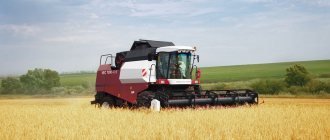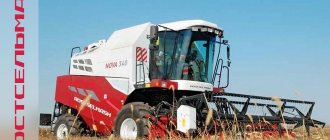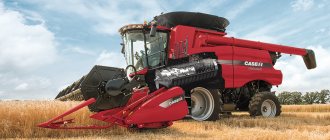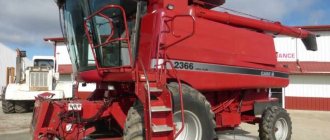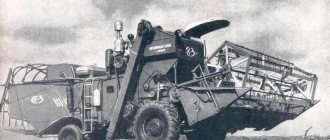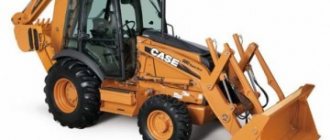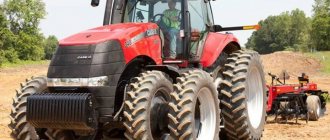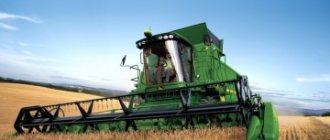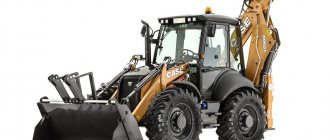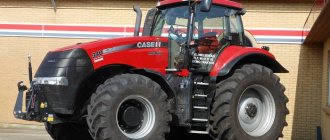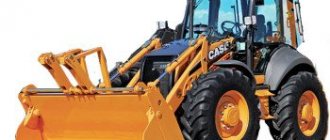The Case 2388 combine is a powerful model for high-yield fields. The equipment has a 2-drum threshing system with an accelerator drum and a straw walker activator, which allows you to use the potential of the machine with maximum efficiency. Case 2388 was created as a machine for working on the ground, which needs not only to be processed, but also to be protected.
The manufacturer of the model is Case IH. Initially, it was a small enterprise founded in 1842 in the USA. After merging with the IH organization in 1985, a new brand appeared (Case IH), which became the second in the world in terms of agricultural machinery production. This allowed the company to expand its product range and begin exporting its products to the European market. In 1999, Case IH merged with New Holland. At the same time, it was not possible to get rid of internal competition, and the production of combines under different brands continued. In the American market, Case products were more popular. In Ukraine, Russia and the countries of the former USSR, the New Holland brand had the advantage, and Case models were quite rare. At the same time, in terms of characteristics and quality, the combines were approximately at the same level. Case IH products appeared on the Russian market in 2013-2014.
Combine Case 2388
The Jerome increase Case company was founded in 1842 in Wisconsin, USA. The first equipment produced by the company was a thresher, which the founder improved to separate straw from grain. International Harvesting was later founded in 1847 and also dealt with agricultural machinery.
In 1902, International Harvesting (IH) and a number of smaller businesses merged, and in 1985 Case and IH merged, after which it received the new name Case IH. The move created the world's second largest agricultural machinery company. There is an opportunity to significantly expand the model range and increase the dealer network and reach many countries around the world.
Peculiarities
The model is equipped with advanced single-rotor Axial-Flow threshing and separation technology. Transportation of the mown mass occurs due to the rotor blades and the feeder conveyor, thereby minimizing the likelihood of damaging the grain. In the threshing system, the mass remains in the section much longer, and during separation it is evenly distributed throughout the entire sieve due to the Cross Flow fan, which makes it possible to obtain the cleanest grain possible.
It is also worth highlighting the no till grinding system for non-grain parts, which has no equal in the quality of grinding and distribution of residues. Photo of the CASE Axial-Flow 2388 combine
Advantages and disadvantages
Advantages of the Case 2388 combine:
- Availability of patented Axial-Flow technology;
- Due to the enormous popularity and quality of the products, not only the company itself has a wide dealer network, but also many third-party companies are engaged in sales;
- The use of hydrodynamic transmission and various computer systems to control the work process.
Despite the popularity and prevalence of dealer centers, there are practically no such excavators in Russia.
Choosing a trawl for transporting a combine harvester
When organizing the transportation of large-sized agricultural equipment on a trawl, some features should be taken into account:
- Most combines are between 4 and 4.5 meters high, which means they may require: wheel removal; raising power lines; registration of an additional permit for the transportation of cargo exceeding a height of 4 meters. Therefore, it should be taken into account that the dimensional parameters will directly affect the price of transportation.
- If the harvester is more than 2.55 meters wide, you will also need to obtain a permit from the appropriate authority.
- The preferred type of loading is self-drive. That is why the most popular machines for transporting a combine are considered to be trawls with a low platform (from 0.3 to 0.5 m) and a front entry, equipped, if necessary, with special extenders.
- Loading with a front drive occurs as follows: the trawl platform is lowered, a combine harvester drives onto it, the wheels of which are removed (if necessary), and then the platform is reattached to the tractor.
- After loading, agricultural machinery must be securely fixed, and also check that the machine is positioned level on the platform. This will avoid unwanted tipping or accidental movement of the combine during transport.
- The cost of renting a trawl can be reduced if the dimensions and weight of the combine allow it to be transported using a semi-trailer.
Device
The rotor cage is divided into a through lower part and a blind upper part. The working bottom is made in the form of separate sections-modules, which must be selected for each harvested crop separately. The upper part has guide bars, to which the combine operator has access and can adjust them in order to change the time the mass remains in the threshing system.
The volume of the bunker was selected in accordance with the productivity of the machine, so that there was no need to unload too often and to reduce trampling of the soil to a minimum. Complete unloading occurs in just two minutes, minimizing downtime.
Diesel engine 6-cylinder with turbocharging and direct injection. Air sequential cooling. The chassis has a hydrostatic 3-speed drive with hydraulic brakes, which ensures maximum reliability and smooth operation.
The machines are equipped with a GPS receiver and the AFS Pro system, which allows you to monitor the condition of the machine and also monitors work productivity.
Specifications
Technical characteristics of the combine harvester case 2388:
| Characteristics | Indicators |
| Power, hp/kW | 325 (2042) |
| Rotor diameter/length, mm | 2800/762 |
| Rotor speed at low/medium/high speed, rpm | 350-400; 400-700; 700-1125 |
| Cleaning area, sq.m | 5,1 |
| Cleaning fan speed, rpm | 450-1250 |
| Hopper capacity, cubic meters m | 7,4 |
| Unloading height, cubic meters m/sec | 0,1 |
| Fuel tank, l | 681 |
| Weight, kg | 12800 |
Video review of the combine case 2388:
Case axial flow 2388 combine harvester: technical specifications, photos and videos
Case axial flow 2388 combine harvester: technical specifications, photos and videos
Regardless of the field of activity, all the largest manufacturers strive to equip their products only with advanced technologies and often patent their own developments, which allow them to remain at the forefront. Case IH is one of them. Thanks to its innovative technologies, the manufacturer is the second largest enterprise in the production of agricultural machinery.
The Jerome increase Case company was founded in 1842 in Wisconsin, USA. The first equipment produced by the company was a thresher, which the founder improved to separate straw from grain. International Harvesting was later founded in 1847 and also dealt with agricultural machinery.
In 1902, International Harvesting (IH) and a number of smaller businesses merged, and in 1985 Case and IH merged, after which it received the new name Case IH. The move created the world's second largest agricultural machinery company.
There is an opportunity to significantly expand the model range and increase the dealer network and reach many countries around the world. The Case Axial-Flow series of combines combines machines that are equipped with the same threshing and separation technology.
Thanks to this, the machines are on a par with the largest manufacturers in the world, and in some respects even far ahead.
The model is equipped with advanced single-rotor Axial-Flow threshing and separation technology.
Transportation of the mown mass occurs due to the rotor blades and the feeder conveyor, thereby minimizing the likelihood of damaging the grain.
In the threshing system, the mass remains in the section much longer, and during separation it is evenly distributed throughout the entire sieve due to the Cross Flow fan, which makes it possible to obtain the cleanest grain possible.
It is also worth highlighting the no till grinding system for non-grain parts, which has no equal in the quality of grinding and distribution of residues. Photo of the CASE Axial-Flow 2388 combine
Advantages and disadvantages
Advantages of the Case 2388 combine:
- Availability of patented Axial-Flow technology;
- Due to the enormous popularity and quality of the products, not only the company itself has a wide dealer network, but also many third-party companies are engaged in sales;
- The use of hydrodynamic transmission and various computer systems to control the work process.
Despite the popularity and prevalence of dealer centers, there are practically no such excavators in Russia.
The rotor cage is divided into a through lower part and a blind upper part. The working bottom is made in the form of separate sections-modules, which must be selected for each harvested crop separately. The upper part has guide bars, to which the combine operator has access and can adjust them in order to change the time the mass remains in the threshing system.
On the separation grid, the grain mass is distributed evenly thanks to the patented Cross Flow fan, which creates a powerful and uniform flow, despite the large grid area.
The volume of the bunker was selected in accordance with the productivity of the machine, so that there was no need to unload too often and to reduce trampling of the soil to a minimum. Complete unloading occurs in just two minutes, minimizing downtime.
Diesel engine 6-cylinder with turbocharging and direct injection. Air sequential cooling. The chassis has a hydrostatic 3-speed drive with hydraulic brakes, which ensures maximum reliability and smooth operation.
The machines are equipped with a GPS receiver and the AFS Pro system, which allows you to monitor the condition of the machine and also monitors work productivity.
Technical characteristics of the combine harvester case 2388:
| Characteristics | Indicators |
| Power, hp/kW | 325 (2042) |
| Rotor diameter/length, mm | 2800/762 |
| Rotor speed at low/medium/high speed, rpm | 350-400; 400-700; 700-1125 |
| Cleaning area, sq.m | 5,1 |
| Cleaning fan speed, rpm | 450-1250 |
| Hopper capacity, cubic meters m | 7,4 |
| Unloading height, cubic meters m/sec | 0,1 |
| Fuel tank, l | 681 |
| Weight, kg | 12800 |
review of combine case 2388:
Case 2388 combine harvester from one of the largest manufacturers in the world, Case IH
Regardless of the field of activity, all the largest manufacturers strive to equip their products only with advanced technologies and often patent their own developments, which allow them to remain at the forefront. Case IH is one of them. Thanks to its innovative technologies, the manufacturer is the second largest enterprise in the production of agricultural machinery.
Review of the main series
2100 Axial Flow
Production of the 2100 Axial Flow series models began in 1995. The combines featured an enlarged cabin, a new external lighting and filtration system.
Specifications:
| Characteristics | Unit measurements | 2166 | 2188 |
| Motor power | hp | 215 | 260 |
| Engine capacity | l | 8,3 | 8,3 |
| Storage tank volume | l | 6300 | 7400 |
Video review of the Case 2166 combine:
2300 Axial Flow
Production of Case 2300 Axial Flow combines began in 1998. All models have a comfortable cabin equipped with a climate control system, a new drive belt and tires that reduce ground pressure and soil compaction.
Technical characteristics of combine harvesters Case 2300 Axial Flow series:
| Characteristics | Unit measurements | 2366 | 2388 |
| Motor power | hp | 240 | 280 |
| Engine capacity | l | 8,3 | 8,3 |
| Storage tank volume | l | 6300 | 7400 |
Photo of the Case Axial Flow 2366 combine
1400 Axial Flow
Models in this series have been produced since 1977. They have an updated corn header, electric rotor control, and electronic monitoring of crop losses.
Model characteristics:
| Characteristics | Unit measurements | 1420 | 1460 |
| Motor power | hp | 124 | 170 |
| Engine capacity | l | 3,58 | 4,36 |
| Storage tank volume | l | 4400 | 6300 |
AFX CNH
AFX CNH equipment has been produced since 2004. The models have an updated rotor, drive belts, a new improved cabin and hydraulic units, the operation of which is controlled by electronic sensors.
Characteristics of AFX CNH series combines:
| Characteristics | Unit measurements | 8010 | 8230 |
| Motor power | hp | 400 | 455 |
| Engine capacity | l | 10,3 | 12,9 |
| Storage tank volume | l | 12300 | 12300 |
Photo of the Case 8010 combine
International 15
The equipment of this series was first released in 1968. Models are equipped with a hydrostat, additional attachments, including a corn header and a device for harvesting rice crops, and a new separator.
Specifications:
| Characteristics | Unit measurements | 315 | 915 |
| Motor power | hp | 72 | 150 |
| Engine capacity | l | 5,5 | 6 |
| Storage tank volume | l | 2460 | 5100 |
Photo of Case 915 combine
Self-propelled harvesters
The first model of the Case self-propelled combine was produced in 1915; in 1925, a combine appeared, the operation of which was mechanized. Over time, combines were improved and equipped with additional equipment for harvesting corn and other crops. Even later, machines for working with rice and legumes appeared.
Technical characteristics of self-propelled combines Case:
| Characteristics | Unit measurements | 101 | 151 |
| Motor power | hp | 58 | 75 |
| Engine capacity | l | 3 | 4,5 |
| Number of cylinders | PC. | 6 | 6 |
88
This newest series has been in production since 2011. The use of electronic controllers and monitors allows you to continuously monitor the operating parameters of the combine.
Technical characteristics of 88 series combines:
| Characteristics | Unit measurements | 5088 | 6088 |
| Motor power | hp | 290 | 330 |
| Engine capacity | l | 8,3 | 10,5 |
| Number of cylinders | PC. | 8810 | 10570 |
The video shows the Case 5088 combine in operation:
130
These models are designed for use on average farmland. At the same time, they are distinguished by high productivity and a wide selection of headers of various sizes.
Special mechanisms allow you to quickly change operating modes depending on weather conditions.
Options:
| Characteristics | Unit measurements | 5130 | 6130 |
| Motor power | hp | 299 | 387 |
| Engine capacity | l | 6,7 | 8,7 |
| Number of cylinders | PC. | 8800 | 10570 |
The video shows the Case 5130 combine harvester in action:
E
Models in this series are designed exclusively for harvesting grain crops. With compact overall dimensions, they have high productivity and power. This feature allows the equipment to be used in large fields with complex terrain. Characteristics of Case E series combine harvester models:
Important Technical characteristics of the Czech front loader UN 053
| Characteristics | Unit measurements | E 521 | E 527 |
| Motor power | hp | 150 | 267 |
This is interesting: Review of model lines of agricultural combines Class - expert advice
Features and device
The design of the combine uses a single-rotor system, which makes it possible to work with high productivity at the lowest cost. The rotor has a device that carefully separates the grains. The design features improved operating technology and is equipped with improved power components.
The combine can be quite simply transferred from the active state to the reverse state. From the bunker, grain enters the grain crusher at high speed, so you can unload the combine directly during operation if you reduce the rotation of the motor. The design of the unit is simple, so you can do minor repairs yourself. The header has a large width, which allows you to get maximum grip and change the angle of inclination when the terrain changes.
A little about the features of Case IH equipment
The main difference between all the cleaning equipment of the brand in question is the use of a unique single-rotor Axial-Flow system. This technology allows you to harvest grain crops at minimal cost with the highest possible productivity.
Thanks to the special design of one rotor, careful separation of raw materials is ensured under the influence of friction and centrifugal force. This way the grains remain intact and the risk of damage is minimized.
The entire design of the Case rotary combine has undergone numerous improvements related to harvesting technology, as well as the functioning of power units.
Before you buy a Shtil gas cutter, you need to familiarize yourself with its varieties and design features.
And here you can learn about the operating features of the Zubr-Extra grain crusher.
Today, this equipment has the most comfortable parameters for work. Its main advantages:
- The unit is easily transferred from the active state to the reverse state , which makes it possible to maneuver in difficult treated areas.
- The high speed of feeding the harvested crop from the bunker allows you to unload the equipment directly during operation, simply by slightly reducing the engine speed.
- Minimum fuel consumption distinguishes this equipment from its competitors.
- The impact on the harvested crop is insignificant , so the output crops remain undamaged, retain all their properties and have an extended shelf life.
- The simple design of the combines makes it possible to independently repair minor breakdowns, as well as regular maintenance and inspection by a full-time employee.
- The wide header provides effective space capture and easily changes the angle of inclination to suit the landscape.
In Russia, Case IH equipment enjoys well-deserved popularity and respect, as it guarantees stable and uninterrupted operation. This is very important during the harvest period, when every day is of great importance.
Models and specifications
The technical characteristics of the grain harvester provide the ability to work in difficult terrain conditions and bad weather. Engine power ensures high performance and speed of work.
The company has developed several models of combines. Their advantages:
- resistance to heavy loads;
- ease of operation;
- availability of maintenance and repair;
- durability of components and parts.
Case 2366
The Case 2366 combine can work with various types of grain crops; the number of moving elements is reduced, which reduces the risk of breakdowns. This series of combines appeared in the last century. The machine is equipped with a climate-controlled cabin and has an improved drive belt. The tire design reduces ground pressure. A mechanism for quick unloading of the bunker has been installed.
The area of the ventilation system and grates has been increased, which improves the grain cleaning process. This combine is a leader in productivity and quality of work among other models in this series. Good driving performance and high power allow the combine to be used for harvesting grains, corn, cereals, and small-seeded crops.
- Dimensions - 6750x3280x3810 mm.
- Weight - 10.3 tons.
- The width of the header is 4900 mm.
- The volume of the grain tank is 6300 l.
- There are 6 straw walkers.
- Diesel engine with a volume of 8.3 liters and a power of 240 kW.
- Compression ratio - 17.
- Number of cylinders - 6.
- Cylinder diameter - 114 mm.
The operation of the chassis is based on hydraulics, which regulates the position of the header, the operation of the brakes and the transmission. The machine runs smoothly and has 3 speeds. Volumetric hydraulic drive and disc brakes are installed. This provides better maneuverability of the equipment and makes it possible to work in narrow areas.
Case 2388
Case 2388 is used for harvesting grain crops in fields that have a large area.
The unit can harvest grains, small seeds, and row crops.
The machine works freely on slopes and surfaces with uneven terrain. The unit can work on wet soils. The device is characterized by high performance. The combine produces high quality grain.
- Dimensions - 7410x3490x3980 mm.
- Ground clearance - 508 mm.
- Wheelbase - 3500 mm.
- Weight - 12800 kg.
- Rotor diameter - 762 mm.
- Rotor length - 2800 mm.
- Rotation speed - 400-700 rpm.
- Cleaning area - 5.1 m².
- Hopper volume 7400 l,
- Unloading speed - 100 l/sec.
- Unloading height - 3900 mm.
- The width of the header is 6100 mm.
- Cleaning fan speed: 450 rpm.
- Fuel consumption - 4.5 liters per 1 ton of grain.
The diesel engine is turbocharged and air cooled. Engine volume - 8.3 l, power - 242 kW, number of cylinders - 6. The combine has a rotor-type threshing and separating mechanism. The hydraulic system controls the header, brakes, and transmission.
Case 6140
Case 6140 is equipped with a system of elevators that feed cleaned grain into the hopper, and the strips are returned to the rotor for re-threshing. The volume of the bunker corresponds to the high productivity of the machine. Contents are uploaded in 2 minutes. This happens while the combine is moving. The chopper is of high quality; it thoroughly crushes the grain and distributes the residue.
- An 8.7 liter engine with a power of 354 hp is installed.
- Speed: 2100 rpm.
- Fuel tank volume - 950 l.
- Weight - 14770 kg.
- Length - 7.69 m.
- Transport width with wheels - 3.5 m.
- Overall height - 4.76 m.
- Transport height - 3.9 m.
- Rotor diameter - 762 mm.
- Rotor length - 2794 mm.
- Rotor speed - 1150 rpm.
- The coverage angle of the threshing modules is 133º.
- Threshing area - 2.7 m².
The upper sieve is for grain and corn, the lower sieve is universal. The cleaning fan has 36 blades. Fan rotation speed is 1300 rpm, cleaning system area is 6.24 m². The volume of the grain tank is 10.5 m², the length of the unloading auger is 6.6 m, the auger productivity is 0.113 m³/sec. GPS system installed. The combine is equipped with an air compressor and a tow hitch.
Model 2166
The 2166 model combine has proven itself well over large areas. The principle of operation is no different from other combines in this series: a key straw walker, a threshing drum supplemented with a beater, a well-thought-out header design.
Case 2166 is equipped with a diesel engine, although less powerful than the previous model - 215 hp. With. The main components of the machine are controlled by hydraulics. The optimal distribution of working power allows you to harvest up to 15,000 kilograms of grain.
Like most European and American cars, control over the main components is carried out using sophisticated electronics. Sensors monitor the position of the cleaning system sieves, the position of the header, grain moisture and the fullness of the bunker.
Combine Case 2166
Case 2388 combine harvester
Consumers call the Case 2388 combine harvester a legendary model. The car was produced for many years and was modernized several times. The production of the equipment was finally completed only in 2010. At the same time, the owners who bought Case 2388 in the early 2000s are not going to give them up. The technical characteristics of the combine remain relevant today, and in terms of reliability and maintenance and repair costs, the machine can easily compete with modern models.
Case 2388 is manufactured by Jerome Increase Case, founded in the USA in 1842. Initially, the brand produced threshing machines and only then moved on to developing full-fledged agricultural machines. Today Case IH (the new name of the company) is one of the leaders in this segment and has a huge dealer network around the world.
Modifications and features
Case 2388 represents the 2300 series, which also includes the Case 2366 model, which is structurally practically no different from it. The more powerful Case 2388 is equipped with a larger hopper (7380 l). Among analogues of other companies, Claas Lexion 580 and John Deerе 9670 are distinguished.
The main feature of the model is the unique single-rotor Axial-Flow system, which allows harvesting with minimal losses and high productivity. Other advantages of the combine include:
- ease of maintenance and repair due to the use of chain and V-belt drives in the design;
- attractive price and quick payback;
- The operator can adjust the operation of the combine (the position of the lower and upper sieve) and check the quality of threshing directly from the cabin. This function reduces operator fatigue, allowing him to perform a larger volume of operations;
- reliability. Failures of the Case 2388 are extremely rare;
- resistance to extreme loads;
- availability and relative cheapness of spare parts;
- high cross-country ability.
Disadvantages of Case 2388:
- The company's dealer network covers the entire world, and many organizations sell Case products. However, in Russia the brand has little distribution, so problems may arise with the purchase and further maintenance of the machine;
- high fuel consumption compared to other foreign analogues;
- relatively weak beam on the header. Defects lead to rapid wear of the scythe and difficulties in adjusting the gap between the bottom of the header and the cantilever auger;
- The bunker, despite its rather large volume, fills quickly with good yields.
Specifications
Overall dimensions (in transport condition):
- length – 7410 mm;
- width – 3490 mm;
- height – 3980 mm;
- wheelbase – 3500 mm;
- ground clearance - 508 mm.
The mass of the combine is 11400 kg.
Performance characteristics:
- width of the standard reaping part – 6100 mm;
- Hopper capacity – 7380 l;
- unloading speed – 100 l/sec;
- unloading height – 3900 mm;
- cleaning system area – 5.1 sq.m;
- cleaning fan rotation speed – 450-1250 rpm;
- number of straw walkers – 6.
In one shift, the combine is capable of processing up to 80-90 hectares of area (average productivity - 45-55 hectares).
Wheel size:
- front axle – HR 480/70 R24;
- rear axle – VR 650/75 32.
Pumpkin harvesters
Specialized equipment for pumpkin harvesting helps to combine the procurement of vegetables and the primary processing of raw materials in the field. The unit allows you to sort the pulp with seeds from the useful mass.
The combine consists of a body on a running chassis with a cabin, an engine, a drum for grinding material, and a separator. The equipment is equipped with an electric drive. The seeds are moved into the hopper along conveyors, and the crushed pumpkin is supplied by an unloading conveyor.
Processing of the collected material is carried out with a cone-shaped separator, to the side walls of which blades are attached, which help in the primary separation of the soft part from the seed material. The seeds are transferred to a tray in which further cleaning of the material is carried out. The grinding drum operates at a speed of 85-150 rpm.
The productivity of the combine is about 20 tons per 1 ha. During the agricultural process with irrigation and fertilizing the soil, it is possible to harvest up to 60 tons per hectare.
The seeds are placed in a special block, the volume of raw materials is up to 2% of the pumpkin weight. Special equipment is designed for drying large volumes of seed material. After processing, the seeds are placed on sheets and dried at a temperature of +40... +45 °C. The material reaches readiness in 12-15 hours, seed moisture is reduced to 7%. At the final stage of drying, the raw materials are mixed.
The use of the unit allows minimizing manual labor and increases the efficiency of large agricultural productions when assembling, loading, and transporting crops to blocks for processing. The equipment can be easily moved to the harvesting site and can be equipped with attachments, sensors, etc.
Engine
Case 2388 is equipped with a 4-stroke diesel engine of its own production, model 6 TAA 8304. A single-row unit with direct injection, sequential air cooling and turbocharging provides the necessary power indicators for the combine. The power plant has a large torque reserve (over 40%) and complies with Euro-3 environmental standards.
The Case 6 TAA 8304 engine is quite power hungry. The average fuel consumption when working on wheat is about 10 l/ha, when working on sunflower – 8.5 l/ha. The disadvantage is compensated by the high productivity of the combine and a large fuel tank that can hold 681 liters of fuel.
Characteristics of the Case 6 TAA 8304 motor:
- working volume – 8.3 l;
- rated power – 242 (325) kW (hp);
- number of cylinders – 6.
Design and operating features
Case 2388 has a hydrostatic undercarriage with a 3-speed drivetrain and hydraulic brakes for smooth operation. The model is equipped with wide tires that reduce pressure on the surface and allow you to move through difficult areas.
Main elements of the combine:
- The reaping part is represented by a standard header with a working width of 6100 mm. In the basic configuration, the system has a hydraulic reverse feeder;
- threshing and separation system. The Case 2388 features proprietary Axial-Flow single-rotor technology. The mown mass remains in the threshing mechanism much longer, and during the separation process it is evenly spread over the sieve using a powerful Cross Flow fan. The movement of the mass is carried out by rotor blades and a conveyor, due to which the risks of grain damage are minimized. The system rotor is located longitudinally and has the following characteristics: length – 2800 mm, diameter – 762 mm, rotation speed – from 250 to 1125 rpm (depending on the operating mode). The rotor cage is divided into lower (through) and upper (blind) parts. The first is considered working and is made in the form of separate module sections with the ability to adjust for a specific type of crop. The upper part is equipped with guide bars with free access. The operator can adjust them to select the length of time the crop remains in the threshing mechanism. The system is adjustable in 3 positions to work with different crops: legumes, grains and oilseeds.
The cleaning system uses a chaff sieve and a shoe sieve with adjustable slats. The air supply is carried out in an intersecting uniform flow, which improves the quality of airflow. In this case, there are no areas of low pressure and “hotter” areas. The main competitor (John Deere) does not have such a feature;
- transportation and storage system. The volume of the bunker for the Case 2388 model was selected taking into account the productivity of the equipment. The developers tried to reduce the frequency of container unloading and reduce soil jams. As a result, the combine received a hopper capacity of 7380 liters with fast unloading (about 2 minutes), due to which equipment downtime was significantly reduced. The unloading auger was equipped with rotation and locking control functions.
The Case 2388 is also equipped with a non-grain part regrinding system (NO TILL). In terms of the quality of grinding and subsequent mass distribution, it has no equal in this segment.
The combine is equipped with a large “Lux” type cabin. The latest modifications have a climate control function, which significantly increases operating comfort. The interior is equipped with a seat with height and height adjustments. Large glasses provide ease of use. The operator performs all basic functions using a multifunctional lever, which allows even an operator with little experience to operate the equipment. Also, all versions of Case 2388 are equipped with the AFS Pro system and a GPS receiver, through which the condition of the equipment is monitored and key performance indicators are tracked. The monitor shows the machine operator the operating parameters, and with its help, fine adjustments are made to improve grain quality and productivity.
Model range LEXION 770/750 - brief information, characteristics
In Claas combines of the LEXION 770/750 models, the designers used the latest developments that allow real-time control of the operation of all mechanisms. The sensor system automatically monitors process parameters. Based on these data, control actions are generated automatically or in a mode previously specified by the operator. The threshing system of the LEXION combine, developed in the company's design bureau specifically for these units, combines two effective technologies - tangential APS and ROTO PLUS separation. The developers called it APS HYBRID SYSTEM.
APS HYBRID SYSTEM in action
Main technical characteristics of the LEXION 770/750 models:
- gentle threshing of grain with maximum productivity;
- careful transportation of grain with maximum productivity;
- electronic control of the radial spreader;
- use of the latest SPECIAL CUT II type chopper;
- the chassis with electro-hydraulic drive ensures road speeds of up to 40 km/h;
- engine power – 524 hp. With.
What does the LEXION 770/750 combine consist of?
Case 2388 combine harvester
The Case 2388 combine is a powerful model for high-yield fields. The equipment has a 2-drum threshing system with an accelerator drum and a straw walker activator, which allows you to use the potential of the machine with maximum efficiency. Case 2388 was created as a machine for working on the ground, which needs not only to be processed, but also to be protected.
The manufacturer of the model is Case IH. Initially, it was a small enterprise founded in 1842 in the USA. After merging with the IH organization in 1985, a new brand appeared (Case IH), which became the second in the world in terms of agricultural machinery production. This allowed the company to expand its product range and begin exporting its products to the European market. In 1999, Case IH merged with New Holland. At the same time, it was not possible to get rid of internal competition, and the production of combines under different brands continued. In the American market, Case products were more popular. In Ukraine, Russia and the countries of the former USSR, the New Holland brand had the advantage, and Case models were quite rare. At the same time, in terms of characteristics and quality, the combines were approximately at the same level. Case IH products appeared on the Russian market in 2013-2014.
Russian combines
Russian-made grain harvesters are represented by several brands:
- Rostselmash, which occupies 70% of the market throughout the Russian Federation, offering a full range of machines for grain harvesting;
- Agromash holding, which continued the traditions of Siberian combine harvesters;
- Terrion company, which implements the concept of the Finnish Sampo combine harvester in Russia;
- The youngest of the combine harvester manufacturers is the Muromets company.
Rostselmash
This is a group of companies including 13 enterprises.
Its units are supplied to 56 countries. Success explained:
- 85-year history associated with the production of combine harvesters;
- a large range of manufactured models;
- optimal ratio of the quality of units and their price;
- presence of a large number of service stations.
The range of grain harvesters includes machines:
- NOVA. Belongs to 3rd class. It is unpretentious and repairable. Has a 180 hp engine. pp., works with headers 3-6 m wide. Has a grain capacity of 4.5 m³.
- Vector series. Model 410 is the same Don 1500, but with a modern body. 450 - tracked - the company's only model with such a propulsion system. Cars with an engine power of 255 hp. With. equipped with 5-9 meter wide headers, they collect grain into a hopper with a capacity of 6 m³.
- The Acros series (grades 5-6), represented by a large number of modifications designed for harvesting grain from different areas. The most popular models are 585/550 and 595. The latter is for large fields with average yield.
- The Torum series (7th class), the new models of which (780/750, 785/770) are among the most productive (40 t/h) rotary machines in the world, are capable of effectively harvesting crops from weedy and wet fields. They have a comfortable cabin, bunkers with a capacity of 10.5 and 12 m³, with Mercedes engines (425, 506 hp). Work is underway to create an unmanned model Torum 760.
- RSM 161. It is versatile and allows you to harvest grains, legumes, cereals, and oilseeds from 2000 hectares of fields per season. The car has a new cabin that provides panoramic visibility.
Agromash
The manufacturer of combine harvesters has been on the domestic market for a long time, but due to a poorly developed dealer network, it cannot boast of great success. It produces several models that are capable of harvesting grains, soybeans, cereal crops, sunflowers, and legumes: Agromash 3000, 4000, 5000, 5121.
Cars of 3-5 classes. Equipped with:
- engines with a power of 180-280 hp. With.;
- headers 4-8 m wide;
- grain storage bins - 5-8 m³.
Terrion
The localization of production of combine harvesters of this brand in Russia is insignificant, although it is constantly expanding. Terrion machines today are Finnish Sampo combines, assembled from large components at a domestic enterprise.
Important TOP 10 brands of gasoline and electric lawn mowers that are worth paying attention to
The line of models is small - 3 series, 1 of which is a mini grain harvester for breeding plots. Rest:
- Series 2000. Includes machines of class 2-3, capable of removing work with a width of 3.1-5.1 m. Units with engine power of 100-185 hp. s., grain bins with a capacity of 3.3-5.5 m³.
- Series 3000, the models of which belong to the 4th class. They have more powerful (210-300 hp) power units and can be equipped with headers 5.1-7.5 m wide. Grain storage bins with a volume of 5.2-7.6 m³.
Muromets
There is only one combine harvester with this name - Muromets 1500. The model is from an enterprise that entered the market in 2014. The firstborn, belonging to the 4th class, has an affordable price, which is explained by:
- high localization;
- simplicity of design.
The machine cannot be classified as an ultra-modern combine harvester. But the cost and low maintenance of the model are attractive to farms with limited profits. It is easy to prepare an operator to operate it; repairs are not difficult due to the availability of spare parts on the market.
Muromets has 1500:
- powerful (240 hp) power unit;
- ability to work with 2 headers with a 6/7 m grip;
- grain bin holding 6.3 m³ of grain.
Video
The main difference between the Case models is the unique single-rotor Axial-Flow mechanism, which allows harvesting at minimal cost and high productivity. The movement of the mown mass is carried out by the feeder conveyor and rotor blades, which reduces the percentage of damaged grain. During the separation process, the mass is evenly distributed over the sieve and allows you to obtain a clean product.
Case 2388 is one of the most popular models of the brand. The design of the equipment has undergone many modifications to improve functional characteristics and cleaning technology. The combine is easy to operate and has a high grain feeding speed. Case 2388 is equipped with a no till grinding system, which has no competitors in the quality of distribution and grinding of residues. Most of the solutions used in the combine are patented and are not found in any other agricultural machine.
The presence of a reverse rotor mode and a loading system improved the controllability of the equipment. The grain processing system in Case 2388 has a minimum number of mechanical tools, which has a positive effect on the quality of grain.
The main area of application for Case 2388 combines is harvesting grain crops in large fields. However, the equipment works equally effectively with various crops (cereals, small seeds, row crops) and allows harvesting on slopes, hills, sandy or rocky soil, in dry or wet conditions. The model is intended for use in medium-sized farms.
Case 2388 provides high productivity and comfortable work. In terms of efficiency and quality of the final grain, the combine has no equal among machines of the 8th and 9th classes.
Cotton harvesters
The raw cotton harvester is designed for processing raw materials on an industrial scale. The first cotton harvesting equipment was patented in the USA in 1793. In Russia, the designs became widespread in their own modifications from the 1st half of the 20th century. Models with pneumatic and spindle systems were designed.
The equipment is produced mounted or as a self-propelled device. Improved models are produced in two- and three-row for fields with a large area.
Cotton harvesting equipment helps optimize the stages of collecting and processing raw materials from the cotton bush. The unit increases the pace of work and mechanizes processes. The machine is optimal for medium and large agricultural enterprises.
The fields are cultivated after the cotton has ripened and defoliated. The equipment moves over rows of raw cotton bolls. The material enters the working slot of the device under the action of a fan, which draws in a stream of air at a speed of 70 m/s. Inside the equipment there is a separator that separates cotton raw materials from weeds and impurities using air flows. The cleaned raw material is transported to a special bunker.
John Deere 7760
One of the most popular combine harvesters in cotton growing is the John Deere 7760. The machine is equipped with a spindle that can simultaneously cut several rows of cotton. Using this type of machine allows you to work without interruption 24 hours a day with a productivity of 9 tons/acre. The John Deere combine is designed for harvesting large area cotton fields.
Cotton growers appreciate this model for its compactness and high productivity, as well as for the excellent quality of the collected material. The spindle picks up several rows of cotton and directs them into a separator, where the cotton is separated from the leaves, after which the mass goes into a drum for smoothing. The finished cotton fibers are collected into large rolls.
Technical characteristics of John Deere 7760:
- Weight – 30.5 tons
- Operating speed – 8 km/h
- Engine power – 500 hp.
- Number of harvested rows – 6
- Dimensions of the finished roll – width 2.5 m, weight 2.2 tons
In the event of a breakdown, the necessary parts can be obtained from the supplier. Repair and maintenance are carried out at branded service centers.
Specifications
Overall dimensions (in transport condition):
- length – 7410 mm;
- width – 3490 mm;
- height – 3980 mm;
- wheelbase – 3500 mm;
- ground clearance - 508 mm.
The mass of the combine is 12800 kg.
Characteristics of the threshing/separation system:
- rotor diameter – 762 mm;
- rotor length – 2800 mm;
- rotation speed – 250-400 rpm (low), 400-700 rpm (medium), 700-1125 rpm (high).
The total cleaning area is 5.1 sq.m.
Other characteristics:
- Hopper capacity – 7400 l and 8300 l (improved version);
- unloading speed – 100 l/sec;
- unloading height – 3900 mm;
- header width (basic) – 6100 mm;
- cleaning fan speed – 450-1250 rpm;
- average fuel consumption is 4.5-5 liters per ton of grain mass.
Design and service features
Case 2388 has proven itself in medium-sized fields. The combine has a threshing and separating mechanism of an axial rotor type (separation and threshing are performed in the rotor). The operation of the chassis is based on hydraulics, which are responsible for the position of the header, the braking system and the transmission, which includes a 3-speed hydraulic drive with hydraulic disc brakes. This system ensures smooth running and high-quality field processing. The Case 2388 offers a high level of maneuverability and is comfortable in confined or irregularly shaped areas.
The combine uses a longitudinally mounted Axial Flow rotor, which ensures high quality threshing and long-term presence of the grain mass during threshing. The rotor cage is divided into a blind upper part and a through lower part. The working (lower) part is made in the form of several module sections, selected separately for a specific crop. The top contains guide bars for easy access. Their adjustment allows you to change the length of time the plant mass remains in the threshing system.
The cleaning system makes the plant flow uniform, which promotes effective cleaning. The shoe sieve and chaff sieve have adjustable slats. The threshing process is controlled by concave with 3 sections, electrically controlled and position display.
Separation of the grain mass is carried out using a unique Cross Flow fan, which creates a uniform and powerful air flow over the entire area.
Threshing of grain in the Case 2388 combine is carried out in 3 phases, performed in a single element system, where the plant mass moves along the rotor plane to the end area with the utmost care. After this, the product passes through the concave, which increases the purity of threshing and separation (up to 90%). The remaining part of the grain is threshed and separated at the rear of the rotor, where special whips are located. Here the grain is shaken and turned, the waste passes through the beater and ends up on the spreading devices.
Case 2388 is equipped with a large hopper, the volume of which was calculated taking into account the productivity of the equipment. The developers tried to reduce trampling of the soil and eliminate the need for frequent unloading. As a result, the duration of unloading the bunker was 2 minutes, which made it possible to reduce equipment downtime.
The combine is equipped with reliable headers and an feeder with a hydraulic reverse system. Also included in the stock modification are:
- straw/chaff spreader;
- fixed hitch for header trolley;
- radio and 2 speakers;
- 2 flashing lights;
- air purification system;
- grain quality control hatch;
- windshield wiper with washer;
- GPS receiver;
- AFS Pro system, which allows you to monitor the condition of the machine and productivity.
Case 2388 is equipped with a comfortable cabin with a spacious interior. Working elements and mechanisms are controlled via an on-board computer, which makes most operations easier. The driver's seat can be adjusted in several directions. The cabin has a heater and air purifier.
Advantages of the Case 2388 combine:
- hydrodynamic transmission;
- patented Axial-Flow technology, which has no analogues in the world;
- maneuverability and ability to work in difficult areas;
- high speed of bunker unloading;
- simplicity of design;
- minimal impact on the crop.
Disadvantages of the Case 2388 combine:
- relatively small hopper capacity;
- high cost of spare parts;
- low prevalence in Russia.
Case 2388 is considered the most reliable and unpretentious combine harvester. However, the equipment requires routine maintenance every 1000 operating hours (oil change - every 250 operating hours). Among the disadvantages of the design is the weak beam of the header, which leads to problems in adjusting the gap between the bottom of the header and the cantilever auger and rapid wear of the scythe.
The new Case 2388 combine will cost 6.7-7.2 million rubles for the basic version. There are relatively few used copies on the Russian market. Price tags for them depend on the condition of the equipment, individual features and configuration. For a used version with little operating time and in good condition, you will have to pay about 4.2-5.1 million rubles (2008-2011).
How to choose a mini grain combine for a farmer
Mini-harvesters are used for harvesting crops on a small plot of land or a field with difficult terrain. Such working conditions require additional maneuverability from agricultural machinery.
Compact grain harvesting units have a number of advantages compared to their larger counterparts. They are characterized by high cross-country ability and reduced sensitivity to changes in terrain. Unlike standard equipment, the mini-harvester easily processes difficult areas.
Manufacturers offer various variations of equipment. The sizes and equipment of mini-harvesters may vary depending on the speed and power of processing crop areas. Today you can buy grain mini-harvesters for farmers, which are smaller copies of traditional models and have a smaller header grip.
A less expensive option is a device that looks like a large walk-behind tractor. Its key difference is that the farmer does not sit in the cabin, but controls the mechanism, following it. At the same time, the functionality and quality of the mechanism does not change.
The economic efficiency and technical characteristics of small grain harvesters for the farm directly depend on the processing area and the size of the equipment. The width of the header can be from 1 to 3 meters.
Before you buy a small grain harvester, you need to decide on the country and reputation of the manufacturer. Grain harvesting equipment manufactured by American and Russian manufacturers is distinguished by its durability and reliability of operation. Chinese-made products do not always meet quality standards.
The technical parameters of small equipment can vary significantly. Before purchasing, you should clearly determine the operating conditions and optimal functionality of the cleaning equipment:
- Base. Mini harvesters are produced mainly on a wheelbase. There are also crawler-mounted models.
- Performance. Such parameters as the width of the header, the power of the power unit, and the speed of operations are taken into account. The farmer should definitely find out the percentage of unharvested ears, the quality of threshing and cleaning of the grain. It is ideal if the buyer calculates the area of land to be processed in advance and evaluates the optimal time spent.
- Model and manufacturer. Feedback from owners of mini-harvesters can provide a lot of useful information about reliable models of equipment. Depending on this, the farmer can choose equipment from a popular brand or choose a new player in the agricultural equipment market.
- Additional functionality. Some models are designed for planting work, while others are adapted for processing forage crops or harvesting rapeseed.
- Method of storing grain. There are models equipped with a hopper compartment or capable of packaging grain into bags. The choice of this criterion depends on the needs of the customer, and whether the grain will be poured into storage or immediately sent for processing.
- Unit power and fuel consumption. All small equipment is equipped with low power engines. There are economical and quite expensive grain harvesting models on sale.
You can understand the operating principle of the mini-harvester by watching a short video review.
